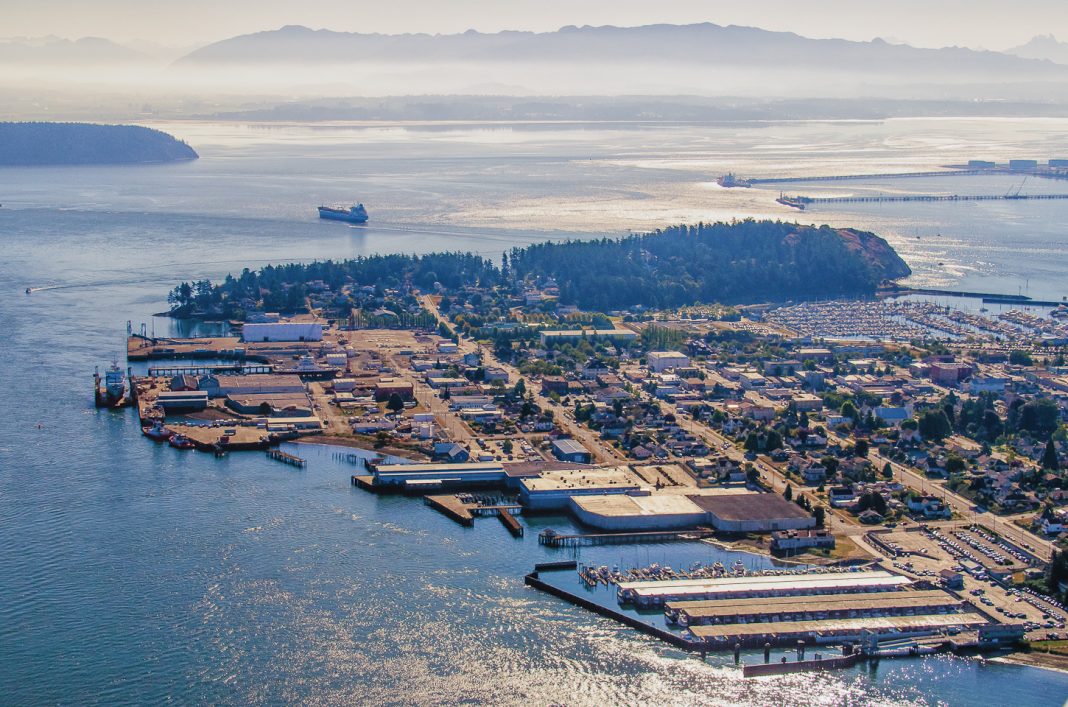Submitted by Washington Emergency Management Division
The Washington Emergency Management Division has completed a Tsunami Maritime Response and Mitigation Strategy for the Port of Anacortes to help the region understand the tsunami risk, build resilience and figure out protective actions to take to enhance life safety and protect property.
Developed in collaboration with Washington Geological Survey, Skagit County Department of Emergency Management, the Port of Anacortes and their key stakeholders, the Tsunami Maritime Response and Mitigation Strategy offers a framework to understand, mitigate and respond to the tsunami risk posed to the maritime community of the Guemes Channel and the Port of Anacortes.
“The threat of tsunamis to the maritime community of the Guemes Channel and the Port of Anacortes is significant,” said Danté DiSabatino, tsunami program coordinator at Washington Emergency Management Division. “With potential damage to infrastructure, vessels and hazardous conditions for those on the water, shoreline and within the inundation zone, it’s imperative that we take proactive measures to enhance life safety and protect property through response planning and analyzing mitigation potential.”
This becomes the third maritime strategy developed for the state of Washington, with strategies already in place for the Port of Bellingham and the Westport Marina. A new strategy is also being written for the Neah Bay area with the Makah Tribe. The completion of this strategy and others is a testament to the collaborative efforts between our agency, local officials and community partners.
“Our continued collaboration with the maritime community underscores our commitment to bolstering resilience and fostering close collaboration in response planning to ensure the safety of our maritime communities during tsunamis,” DiSabatino said.
In addition to the strategy, revised protective guidance for boaters has been created with plans to distribute the guidance to boat owners, commercial fishermen, local U.S. Coast Guard and others.
“As a coastal community, Anacortes has been living with and managing geologic and climate-related risks for a long time,” said Port of Anacortes Director of Operations John Dumas. “Thanks to this partnership and the expertise available through EMD, we can manage risks more holistically, protect people and property and recover more quickly should an event happen. We appreciate the hard work and coordination that went into developing this strategy and look forward to coordinating with our partners to continue to protect our community.”
“This strategy marks a significant step forward in safeguarding our community and maritime assets,” said Julie de Losada, Skagit County chief of emergency management. “By understanding our vulnerabilities and implementing practical measures, we can better protect lives, property and our local economy. We are grateful for the strong partnerships that made this strategy possible and look forward to continuing our collaborative efforts.”
The study includes new modeling created by the Washington State Geological Survey looking at tsunami impacts for the Port of Anacortes and parts of the nearby Guemes Channel as a result of a local magnitude 9.0 earthquake along the Cascadia Subduction Zone and a distant magnitude 9.2 earthquake along the Alaska-Aleutian Subduction Zone. It is the first time modeling has been done in this region at such a local level.
The strategy includes a detailed local area modeling for a distant Alaska tsunami. Washington Geological Survey anticipates releasing state-wide tsunami modeling for a distant magnitude 9.2 earthquake along the Alaska-Aleutian Subduction Zone in 2025.
“Notably, modeling from this study suggests that even a large earthquake off the coast of Alaska can still generate warning-level waves that exceed three feet in height within Cap Sante Marina,” says Alex Dolcimascolo, a tsunami geologist from Washington Geological Survey. “Another key take-away from this study is that the initial tsunami impacts to the maritime community transpire much earlier than previously anticipated after a local Cascadia subduction zone event. Based on the modeling, we can expect the first sign of a one-foot drawdown, or water pulling away from shore, in as soon as 50 minutes within Guemes Channel once the shaking begins. This precedes the first inundating wave by nearly an hour and could have major implications in tsunami response planning.”
The Port has experienced significant growth in recent years, with a steady increase in ship and barge traffic. More than 120 deep-water vessels called the Port in 2022, highlighting its importance as a major maritime gateway. The Port of Anacortes also has active ferry terminals and a busy marina and hosts multiple tenants, recreational watercraft and thousands of visitors on Port properties each year.
Improvements at the Port would help with potential tsunamis and also bolster resilience against more frequent hazards like extreme storms, king tides, floods and sea-level rise due to climate change.
The strategy looks at what immediate actions the Port could take if a tsunami threat is known to be on the way, including evacuations and restricting maritime traffic. It also includes longer-term mitigation strategies and how those actions could potentially be funded. For instance, installing new signage at the Port could be provided via the Washington Emergency Management Division as funding allows while a suggestion to increase the size and stability of dock pilings could come from a combination of local capital improvement budget and federal mitigation grant funds.
Other suggestions include studying the structural integrity and resiliency of infrastructure owned by the Port and the United States Army Corps of Engineers and increasing public education among tenants and visitors.
Read the report at this link. Learn more about Port of Anacortes.




































